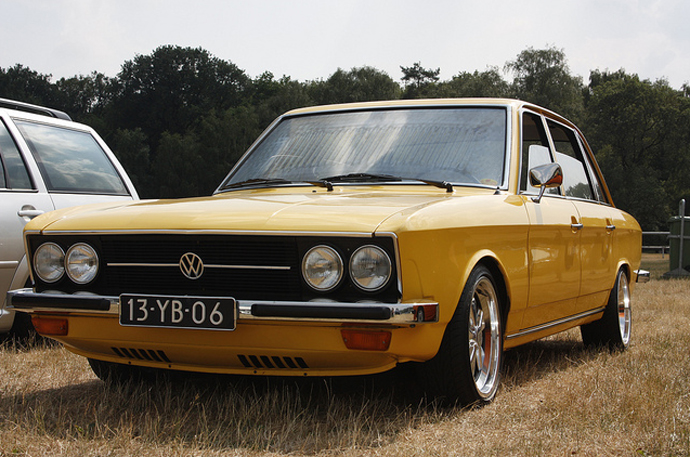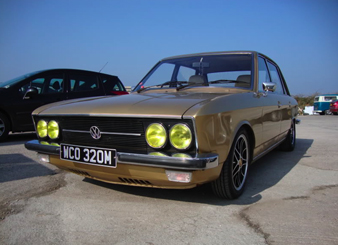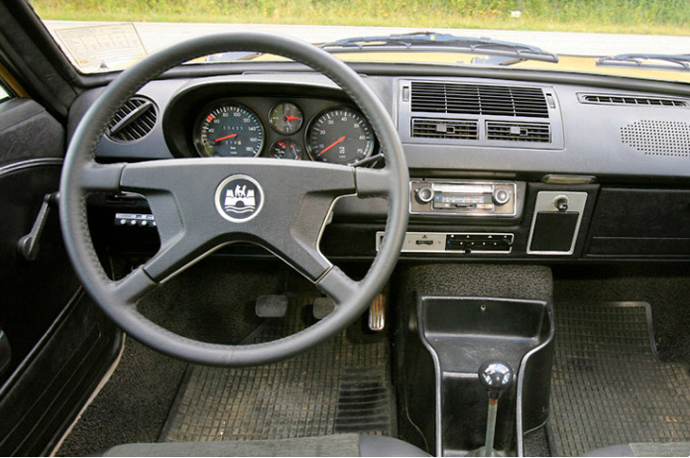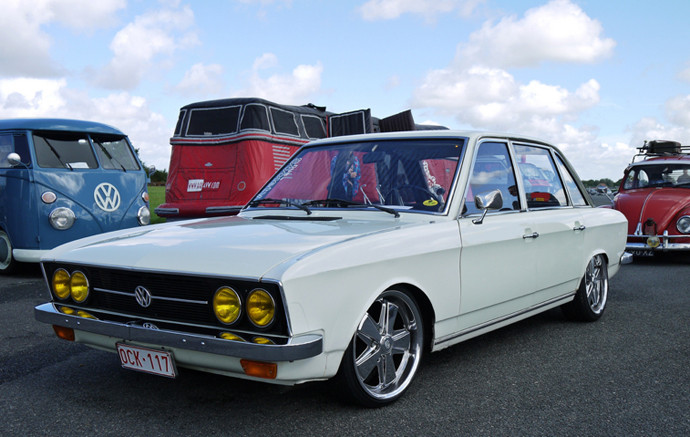The K70 was a history changer – a car that bravely broke from tradition and formed the foundation stone for all subsequent VWs – cars that would ultimately raise Volkswagen from obscurity to virtual world domination. Yet today the K70 remains unloved and now virtually forgotten…
That’s probably because if we’re honest, it wasn’t all that sexy – although its crisp squared off styling has come back into fashion and does have a certain retro appeal.

The car started off as a NSU concept, but was taken over and rebranded by VW when it bought out the Neckarsulm firm in 1969. For VW it represented uncharted territory in terms of its front-mounted, 1605cc 74bhp overhead-cam water-cooled engine developed from the air-cooled 1200cc NSU Prinz. MacPherson struts up front and independent semi-trailing arms and wishbones at the rear made the K70 handle well, although a front end weight bias created understeer when pushed to the limit. Something that unnerved testers at the time and has deterred enthusiastic drivers ever since. Subsequent tuning and capacity increases to 90bhp and 99bhp (from the 1973 1807cc K70S) only served to highlight the car’s handling deficiencies.


In a nutshell, despite the significant part it played in Volkswagen history, the K70 failed to shine and the car struggled to find buyers. It doggedly soldiered on until early 1975 after just five years of production at VW’s new Salzgitter plant, by which point the Passat and the Audi 80 were already stealing sales. Just 210,000 were made making it incredibly niche considering VW’s usual production numbers.

The legacy of the K70 lives on, but in contrast to the massive rise in appeal of the Mk1 Golf, it’s only got a relatively niche following here. That said, their retro appeal seems to be blossoming – especially on the continent – and as interest slowly grows, so will prices.
If all this has tickled your fancy, there’s just a few tips when buying. Specifically, be wary of any cooling issues as well as any that omit blue smoke on the overrun which points to worn valve guide seals. If you are into originality, beware too of missing trim which is becoming more and more difficult to source. Rust can also be a major worry, especially in the bulkhead, sills and inner wings.

Assuming you manage to find one, a project could be yours for as little as £1,000 while a nice one shouldn’t be much more than £3,000.
Ian
The opinions expressed here are the personal opinions of the author and do not necessarily represent the views and opinions of VW Heritage


The K70 helped “raise VW from obscurity”….?! Really?! Poor little VW that had only just been managing to sell a million cars a year at that time? They’d been dominating the world quite nicely with the Beetle for quite a few years already by then.
There was a real fear within VW in the late ’60s/early ’70s that they were in danger of becoming a one trick pony. The Beetle was a massive success, yes, but they needed to broaden their appeal. Which is why the front engined, front wheel drive range of cars was such a radical departure at the time. Obviously, the move paid off…
I have ridden in a K70 , back in the mid 1970s a friend bought one 2nd hand, although his wife hated it and it went after a short period.
It was very roomy inside and the boot was huge, interior was airey, a bit like the 412 Variant I had at the time. It was 40 years ago, almost, but I seem to remember it drove nicely and was quite quiet. It was originally destined to be an NSU iirc.
I worked for VW for over 50 years and remember the K70 created quite a stir at the time….You could change the clutch in 15 mins without taking the gearbox out and it was the only engine at the time that ran “backwards”
Other people’s engines ran ‘backwards’ too. Renault’s 3 bearing 850 ran the opposite way to the 5 bearing 950-1300 engines.
Sorry…I should have said ..The only vw engine that ran contrary to the no..I liked the K70…It started on the drawing boards as an NSU when the VW group took them over,hence carried on and just rebadged it.The original 1600 was a bit slow but when they introduced the 1800 it wasn’t a bad car .
Hi Colin,
I have a question. Could you give me some information on how to change the clutch on a k70? And is the clutch interchangable with other vw clutches?
Please let me know ok?
Thanks!
Jim
this is very helpful information, it would have been more helpful if I’d have found it before purchasing one. Lol. It’s on it’s way over from Sweden. There is currently 7 registered in the UK so mine will be number 8.
Not sure about “the foundation stone for all subsequent VWs”.. The K70 was an evolutionary deaed-end.. All subsequent water cooled VWs were pure DKW / Auto-Union mechanical lineage.
Whilst a student, I owned and drove a 1973 K70L (OPJ 976L) between 1989 and 1992. 1605cc, 90hp. It was one of just 12 known to exist in the UK at the time, out of a total right-hand-drive production of 800. Clearly not a big seller in the UK (or indeed anywhere), but it was VW’s stop-gap solution to getting a FWD, watercooled car into the market until the Golf, Passat and Audi 80 were ready to be launched.
The “K” in the model name stood for “Kolben”, German for piston, to distinguish it from its NSU sister, the Ro (for “rotary”) 80, and yes, it was designed by NSU and was virtually ready to launch with the NSU badge had VW not inherited it as part of a takeover. That takeover only happened because the warranty costs associated with the early Ro80s very nearly made NSU insolvent, and NSU themselves knew they had to design and build a piston-engined “big car” to try to claw back at least some of the losses. Of course, by then it was all a bit too late.
As has been commented elsewhere, the K70 shared virtually no parts with any other VW, apart from maybe the oil and air filter. The Kienzle/VDO instrumentation was similar in appearance to the Mk.1 Passat, but they were not interchangeable! Even the indicator and windscreen wiper stalks were unique to the car.
The interior was quite wide, and back seat passengers certainly had room to spread themselves out. It wasn’t quite so good up front – there was no room for your left foot to rest, so you had to rest on the clutch pedal. Difficult to engage second gear when cold. Headrests were an optional extra, and my car didn’t have them. The carburettor was a Solex 18/32 DDHT with twin chokes, and the engine itself was canted over at an angle. Unassisted steering – God only knows how I coped with that back then, but three point turns and parking were not fun! That said, once it got going, it rode pretty well (thanks to the suspension’s similarity with the NSU Ro80) and it was reasonable on fuel (98 RON 4-star only) despite its weight.
In those pre-Internet days, I had to resort to asking family friends in Germany to see if they could find a complete kit of parts to rebuild the engine, and they duly managed to find one at the Raffay dealership in Hamburg! It was packed with gaskets, valve stem seals, crankshaft bearing shells, piston rings, the lot. Total cost was just £165 for the kit, so I guess they must have been trying to get rid of it for a while. None of the VW dealers in the UK at the time had anything left on the shelves for a K70 – I know the Parts Desk at Colindale VW used to think I was a bit mad to be running one, as all they had left for it was the parts microfiche and a brake switch!
I sold the car to an enthusiast in Essex. Some years later I bought a 1973 NSU Ro80…..
What a fantastic story, thanks for sharing it. The K70 was certainly ahead of its time, as was the Ro80 obviously. I too had an Ro80, I paid £50 for it from a garage on Apex Corner in north London. Bodily it was good but the Rotary engine had been replaced with a Ford powerplant (I think from a Corsair) which was burning a lot of oil. My folks bought a Bay Window Bus from Colindale in the late 1970s – it was on their forecourt. Best wishes, Ian